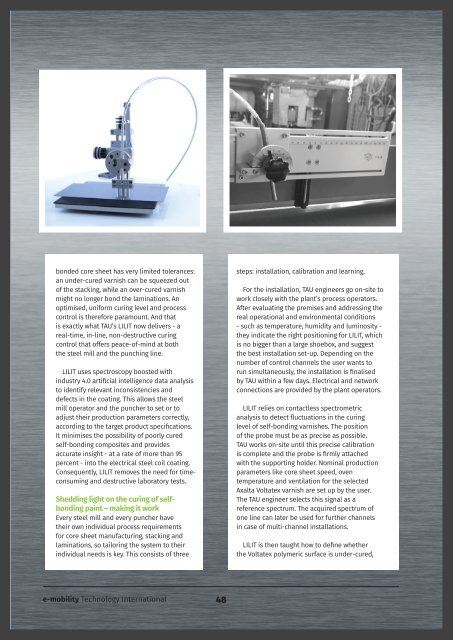E-mobility Technology Summer 2020
Engage with the innovators who are making the shift to electric vehicles a reality
Engage with the innovators who are making the shift to electric vehicles a reality
You also want an ePaper? Increase the reach of your titles
YUMPU automatically turns print PDFs into web optimized ePapers that Google loves.
THINK HOLISTIC<br />
BATTERY<br />
MATERIALS<br />
SYNTHETIC<br />
RUBBER<br />
bonded core sheet has very limited tolerances:<br />
an under-cured varnish can be squeezed out<br />
of the stacking, while an over-cured varnish<br />
might no longer bond the laminations. An<br />
optimised, uniform curing level and process<br />
control is therefore paramount. And that<br />
is exactly what TAU’s LILIT now delivers - a<br />
real-time, in-line, non-destructive curing<br />
control that offers peace-of-mind at both<br />
the steel mill and the punching line.<br />
LILIT uses spectroscopy boosted with<br />
industry 4.0 artificial intelligence data analysis<br />
to identify relevant inconsistencies and<br />
defects in the coating. This allows the steel<br />
mill operator and the puncher to set or to<br />
adjust their production parameters correctly,<br />
according to the target product specifications.<br />
It minimises the possibility of poorly cured<br />
self-bonding composites and provides<br />
accurate insight - at a rate of more than 95<br />
percent - into the electrical steel coil coating.<br />
Consequently, LILIT removes the need for timeconsuming<br />
and destructive laboratory tests.<br />
Shedding light on the curing of selfbonding<br />
paint – making it work<br />
Every steel mill and every puncher have<br />
their own individual process requirements<br />
for core sheet manufacturing, stacking and<br />
laminations, so tailoring the system to their<br />
individual needs is key. This consists of three<br />
steps: installation, calibration and learning.<br />
For the installation, TAU engineers go on-site to<br />
work closely with the plant’s process operators.<br />
After evaluating the premises and addressing the<br />
real operational and environmental conditions<br />
- such as temperature, humidity and luminosity -<br />
they indicate the right positioning for LILIT, which<br />
is no bigger than a large shoebox, and suggest<br />
the best installation set-up. Depending on the<br />
number of control channels the user wants to<br />
run simultaneously, the installation is finalised<br />
by TAU within a few days. Electrical and network<br />
connections are provided by the plant operators.<br />
LILIT relies on contactless spectrometric<br />
analysis to detect fluctuations in the curing<br />
level of self-bonding varnishes. The position<br />
of the probe must be as precise as possible.<br />
TAU works on-site until this precise calibration<br />
is complete and the probe is firmly attached<br />
with the supporting holder. Nominal production<br />
parameters like core sheet speed, oven<br />
temperature and ventilation for the selected<br />
Axalta Voltatex varnish are set up by the user.<br />
The TAU engineer selects this signal as a<br />
reference spectrum. The acquired spectrum of<br />
one line can later be used for further channels<br />
in case of multi-channel installations.<br />
LILIT is then taught how to define whether<br />
the Voltatex polymeric surface is under-cured,<br />
FIBERS &<br />
TEXTILES<br />
ELECTRONICS<br />
PERFORMANCE<br />
PLASTICS<br />
FOAM<br />
MATERIALS<br />
e-<strong>mobility</strong> <strong>Technology</strong> International 48<br />
WE MAKE FUTURE MOBILITY WORK .<br />
automotive-asahi-kasei.eu









